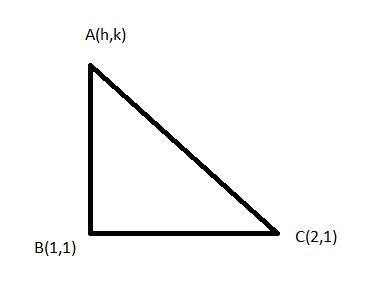
Let \[A\left( {1,{\text{ }}k} \right)\], \[B\left( {1,1} \right)\]and \[C\left( {2,1} \right)\] be the vertices of a right-angled triangle with \[AC{\text{ }}\]as its hypotenuse. If the area of the triangle is 1, then the set of values that k can take is given by
(A) \[\left\{ {{\mathbf{1}},{\mathbf{3}}} \right\}\]
(B) \[\left\{ {{\mathbf{0}},{\mathbf{2}}} \right\}\]
(C) \[\left\{ {-{\mathbf{1}},{\mathbf{3}}} \right\}\]
(D) \[\left\{ {-{\mathbf{3}},-{\mathbf{2}}} \right\}\]
Answer
222.9k+ views
Hint: We are given the three vertices of a right-angled triangle. Using the distance formula and Pythagoras’ theorem the value of h can be found. By substituting the value of h and other known values in the area of the triangle formula we can obtain the value of k.
Formula Used:
The distance between the two points \[\left( {{x_1},{y_1}} \right)\]and \[\left( {{x_2},{y_2}} \right)\] is given by the distance formula.
\[d=\sqrt{(\mathrm{(x_2-x_1)}^2)+(\mathrm{(y_2-y_1)}^2)}\]
The Pythagoras theorem equation is expressed as, \[A{C^2} = A{B^2} + B{C^2}\] where \[AC\]= hypotenuse of the right triangle and\[AB\ ]and \[BC\]are the other two sides.
Complete step by step Solution:
\[\because A(h,k)\], \[B(1,1)\;\]and \[C(2,1)\;\]are the vertices of a right-angled triangle ABC we have,

Here \[AB = \sqrt {{{(1 - h)}^2} + {{(1 - k)}^2}} \] , \[BC = \sqrt {{{(2 - 1)}^2} + {{(1 - 1)}^2}} = 1\] and \[CA = \sqrt {{{(h - 2)}^2} + {{(k - 1)}^2}} \]
We know that Pythagoras' theorem is
\[A{C^2} = A{B^2} + B{C^2}\]
\[ \Rightarrow 4 + {h^2} - 4h + {k^2} + 1 - 2k = {h^2} + 1 - 2h + {k^2} + 1 - 2k + 1\]
\[ \Rightarrow \,5 - 4h = 3 - 2h\]
\[ \Rightarrow \,h = 1\]
We are given that area of the triangle is 1,
Hence \[area(\vartriangle ABC) = \dfrac{1}{2} \times AB \times BC\]
\[ \Rightarrow 1 = \dfrac{1}{2} \times \sqrt {{{(1 - h)}^2} + {{(1 - k)}^2}} \times 1\]
\[ \Rightarrow 2 = \sqrt {{{(1 - h)}^2} + {{(1 - k)}^2}} \]
Putting h=1 in the above equation we get,
\[ \Rightarrow 2 = \sqrt {{{(1 - k)}^2}} \]
Squaring on both sides we get,
\[ \Rightarrow 4 = {(1 - k)^2}\]
\[ \Rightarrow 4 = 1 - 2k + {k^2}\]
\[ \Rightarrow {k^2} - 2k - 3 = 0\]
On factoring by splitting the middle term we get,
\[ \Rightarrow {k^2} - 3k + k - 3 = 0\]
\[ \Rightarrow (k - 3)(k + 1) = 0\]
\[ \Rightarrow k = - 1,3\]
Hence, the correct option is C.
Note: In order to solve the given question, one must know to find the distance between two points.
The distance between the two points \[\left( {{x_1},{y_1}} \right)\]and \[\left( {{x_2},{y_2}} \right)\] is given by the distance formula.
Formula Used:
The distance between the two points \[\left( {{x_1},{y_1}} \right)\]and \[\left( {{x_2},{y_2}} \right)\] is given by the distance formula.
\[d=\sqrt{(\mathrm{(x_2-x_1)}^2)+(\mathrm{(y_2-y_1)}^2)}\]
The Pythagoras theorem equation is expressed as, \[A{C^2} = A{B^2} + B{C^2}\] where \[AC\]= hypotenuse of the right triangle and\[AB\ ]and \[BC\]are the other two sides.
Complete step by step Solution:
\[\because A(h,k)\], \[B(1,1)\;\]and \[C(2,1)\;\]are the vertices of a right-angled triangle ABC we have,

Here \[AB = \sqrt {{{(1 - h)}^2} + {{(1 - k)}^2}} \] , \[BC = \sqrt {{{(2 - 1)}^2} + {{(1 - 1)}^2}} = 1\] and \[CA = \sqrt {{{(h - 2)}^2} + {{(k - 1)}^2}} \]
We know that Pythagoras' theorem is
\[A{C^2} = A{B^2} + B{C^2}\]
\[ \Rightarrow 4 + {h^2} - 4h + {k^2} + 1 - 2k = {h^2} + 1 - 2h + {k^2} + 1 - 2k + 1\]
\[ \Rightarrow \,5 - 4h = 3 - 2h\]
\[ \Rightarrow \,h = 1\]
We are given that area of the triangle is 1,
Hence \[area(\vartriangle ABC) = \dfrac{1}{2} \times AB \times BC\]
\[ \Rightarrow 1 = \dfrac{1}{2} \times \sqrt {{{(1 - h)}^2} + {{(1 - k)}^2}} \times 1\]
\[ \Rightarrow 2 = \sqrt {{{(1 - h)}^2} + {{(1 - k)}^2}} \]
Putting h=1 in the above equation we get,
\[ \Rightarrow 2 = \sqrt {{{(1 - k)}^2}} \]
Squaring on both sides we get,
\[ \Rightarrow 4 = {(1 - k)^2}\]
\[ \Rightarrow 4 = 1 - 2k + {k^2}\]
\[ \Rightarrow {k^2} - 2k - 3 = 0\]
On factoring by splitting the middle term we get,
\[ \Rightarrow {k^2} - 3k + k - 3 = 0\]
\[ \Rightarrow (k - 3)(k + 1) = 0\]
\[ \Rightarrow k = - 1,3\]
Hence, the correct option is C.
Note: In order to solve the given question, one must know to find the distance between two points.
The distance between the two points \[\left( {{x_1},{y_1}} \right)\]and \[\left( {{x_2},{y_2}} \right)\] is given by the distance formula.
Recently Updated Pages
JEE General Topics in Chemistry Important Concepts and Tips

JEE Extractive Metallurgy Important Concepts and Tips for Exam Preparation

JEE Atomic Structure and Chemical Bonding important Concepts and Tips

JEE Amino Acids and Peptides Important Concepts and Tips for Exam Preparation

Electricity and Magnetism Explained: Key Concepts & Applications

JEE Energetics Important Concepts and Tips for Exam Preparation

Trending doubts
JEE Main 2026: Application Form Open, Exam Dates, Syllabus, Eligibility & Question Papers

Derivation of Equation of Trajectory Explained for Students

Hybridisation in Chemistry – Concept, Types & Applications

Understanding the Angle of Deviation in a Prism

How to Convert a Galvanometer into an Ammeter or Voltmeter

Degree of Dissociation: Meaning, Formula, Calculation & Uses

Other Pages
JEE Advanced Marks vs Ranks 2025: Understanding Category-wise Qualifying Marks and Previous Year Cut-offs

NCERT Solutions for Class 11 Maths Chapter 10 Conic Sections

NCERT Solutions for Class 11 Maths Chapter 9 Straight Lines

NCERT Solutions For Class 11 Maths Chapter 8 Sequences And Series

NCERT Solutions For Class 11 Maths Chapter 12 Limits And Derivatives

Ideal and Non-Ideal Solutions Explained for Class 12 Chemistry




